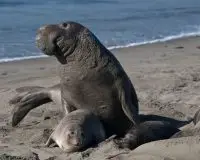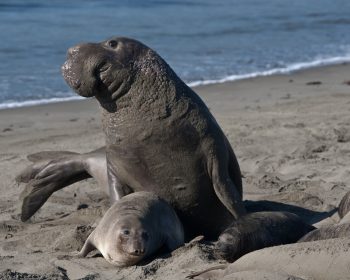Elephant seals belong to the group of true seals. As compare to other seals, they are much larger in size. The two species of elephant seals are southern elephant (Mirounga leonina) and northern elephant (Mirounga angustirostris) seals. Southern elephant seals are larger than the northern ones.
Unlike cows (adult females), bulls (adult males) have large trunk-like proboscis, which is used in making loud calls.
In size, bulls are much larger than the cows. The bulls of southern elephant can grow up to 16 feet in length and weigh around 6,600 pounds. However, some of these seals can be as long as 20 feet in length and weigh 8,800 pounds. The southern elephant cows are 10 feet long and weigh around 2,000 pounds. The northern elephant bulls have size range of 14 to 16 feet and weigh up to 5,500 pounds.
On average, the southern  elephant seal has a lifespan of 20 to 22 years while northern elephant has a shorter lifespan of up to 9 years.
elephant seal has a lifespan of 20 to 22 years while northern elephant has a shorter lifespan of up to 9 years.
Normally, the maturity age for the bulls is around 5 to 6 years. However, the peak maturity age starts from 9 to 12 years. A female produces single pup.
The northern elephant seals are distributed off the coasts of Mexico, Canada and the U.S. in the Pacific Ocean. The southern elephants are found off the Atlantic coasts of Argentina, South Africa and New Zealand. To the south, they inhabit islands like Macquarie and South Georgia. The Valdes Peninsula of Argentina is home to the fourth-biggest colony of such seals.
Elephant seals feed mainly on large fish, octopuses, eels, squid and smaller sharks, skates and rays.
They can dive up to a depth of 5,085 feet. The recorded deepest dive by a southern elephant is 7,835 feet. However, on average, the dive is not more than 1,970 feet deep. Elephant seals can swim without breathing for 100 minutes and stay underwater for 2 hours because they have a lot of blood inside and hence, oxygen.
In the 19th century, southern and northern elephant seals were hunted to the brink of extinction, mainly for oil. However, their population has since returned to normal.





